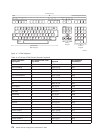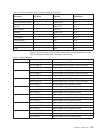specification of user-defined mapping tables. If these are not required, the default
value of *CCSID allows for character mapping by using the mode specified in the
CCSID parameter.
VTxxx—Multinational Mode
The multinational mode supports the DEC multinational character set, which is an
8-bit character set that contains most characters used in the major European
languages. The ASCII character set is included in the DEC multinational character
set. The DEC multinational character set is used by default.
VTxxx—National Mode
The national mode supports the national replacement character set, which is a
group of 7-bit character sets. Only one national character set is available for use at
any one time. VT220 also supports the standard 7-bit ASCII character set as part of
the national mode. The VT220 terminal supports the following 7-bit ASCII national
language character sets:
v British
v Dutch
v Finnish
v French
v French/Canadian
v German
v Italian
v Norwegian Danish
v Spanish
v Swedish
v Swiss
v US English
To use a national mode, mapping tables are required to map incoming ASCII data
into EBCDIC and outgoing EBCDIC data into ASCII when operating in VTxxx
full-screen mode.
A national mode (NLS mapping table) may be selected with the CCSID parameter
on the Telnet command (see “VTxxx—Start TCP/IP Telnet Command” on page 166).
A numeric value representing a registered CCSID value in the range 1-65553 may
be entered to identify the appropriate mapping table. Details of registered CCSIDs
are found in the
International Application Development
book.
The NLS mapping tables are built dynamically to a remote system the first time
Telnet is used, and are based on DEC national replacement character sets.
Because the character sets are based on 7 bits, they can contain only the unique
characters from one country. Because the DEC multinational character set is based
on 8 bits, it has sufficient bits to allow the unique characters from a group of
countries to be included.
180 OS/400 TCP/IP Configuration and Reference V4R4


















